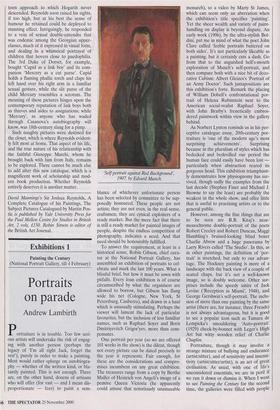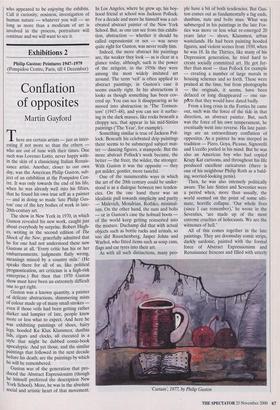Exhibitions 1
Painting the Century (National Portrait Gallery, till 4 February)
Portraits on parade
Andrew Lambirth
Portraiture is in trouble. Too few seri- ous artists will undertake the risk of engag- ing with another person (perhaps the legacy of 'I'm all right Jack, forget the rest'), purely in order to make a painting. Most would rather splurge on autobiogra- phy — whether of the written kind, or bla- tantly painted. This is not enough. There are, on the other hand, dozens of artisans who will offer (for vast — and I mean dis- proportionate — fees) to paint a sem- `Self-portrait against Red Background, 1907, by Edvard Munch blance of whichever unfortunate person has been selected by committee to be sup- posedly honoured. These people are not artists; they are not even, in the real sense, craftsmen; they are cynical exploiters of a ready market. But the mere fact that there is still a ready market for painted images of people, despite the endless competition of photography, indicates a need. And that need should be honourably fulfilled.
To answer the requirement, at least in a historical sense, Robin Gibson, chief cura- tor at the National Portrait Gallery, has assembled an exhibition of portraits to cel- ebrate and mark the last 100 years. What a blissful brief, but how it must be sown with pitfalls. Every loan exhibition is of course circumscribed by what the organisers are allowed to borrow, but Gibson has flung wide his net (Cologne, New York, St Petersburg, Canberra), and drawn in a haul which is unusually stimulating. Perhaps the viewer will lament the lack of particular favourites, but the inclusion of less familiar names, such as Raphael Soyer and Boris Dmitriyevitch Grigor'yev, more than com- pensates.
One portrait per year (so we are offered 101 works in the show) is the diktat, though not every picture can be dated precisely to the year it represents. Fair enough, for these are the considerations and compro- mises incumbent on any great exhibition. The treasures range from a copy by Berthe Muller of Heinrich von Angeli's image of a pensive Queen Victoria (he apparently could amuse that notoriously unamusable monarch), to a video by Marty St James, which can seem only an aberration when the exhibition's title specifies 'painting'. Yet the sheer wealth and variety of paint- handling on display is beyond dispute. An early work (1906), by the ultra-stylish Bol- dini, put me in mind of what the poet John Clare called 'feeble portraits buttered on both sides'. It's not particularly likeable as a painting, but it certainly cuts a dash. Go from that to the anguished hell's-mouth exploration of Munch's self-portrait, and then compare both with a nice bit of deco- rative Cubism: Albert Gleizes's 'Portrait of an Army Doctor'. Such juxtapositions are this exhibition's forte. Remark the placing of William Dobell's confrontational por- trait of Helena Rubinstein next to the American social-realist Raphael Soyer, with John Bratby's frenetically embroi- dered paintwork within view in the gallery behind.
As Norbert Lynton reminds us in his per- ceptive catalogue essay, 20th-century por- traiture is 'one of the modern age's most surprising achievements'. Surprising because in the pluralism of styles which has bedecked and bedevilled our period the human face could easily have been lost — particularly when abstraction reared its gorgeous head. This exhibition triumphant- ly demonstrates how physiognomy has sur- vived, though sadly the examples from the last decade (Stephen Finer and Michael J. Browne to say the least) are probably the weakest in the whole show, and offer little that is useful to practising artists or to the general public.
However, among the fine things that are to be seen are R.B. Kitaj's near- monochrome double-portrait of the poets Robert Creeley and Robert Duncan, Maggi Hambling's bruised-looking blind boxer Charlie Abrew and a huge panorama by Larry Rivers called 'The Studio'. In this, as in other paintings, the definition of 'por- trait' is stretched, but only to our advan- tage. The Hockney painting is more of a landscape with the back view of a couple of seated chaps, but it's not a well-known image, so is doubly welcome. Other sur- prises include the speedy satire of Jack Levine (`Reception in Miami', 1948), and George Gershwin's self-portrait. The inclu- sion of more than one painting by the same artist (there are, for instance, three Freuds) is not always advantageous, but it is good to see a popular icon such as Tamara de Lempicka's smouldering 'Auto-portrait' (1929) cheek-by-bonnet with Leger's High Art but witty wooden relief of Charlie Chaplin.
Portraiture, though it may involve a strange mixture of bullying and endurance (artist/sitter), and of sensitivity and insensi- tivity (artist/sitter/artist), is an act of great civilisation. As usual, with one of life's unconsidered essentials, we are in peril if we run it down or dismiss it. When I went to see Painting the Century for the second time, the galleries were filled with people who appeared to be enjoying the exhibits. Call it curiosity, nosiness, investigation of human nature — whatever you will — so long as more than a modicum of art is involved in the process, portraiture will continue and we will want to see it.






























































































 Previous page
Previous page